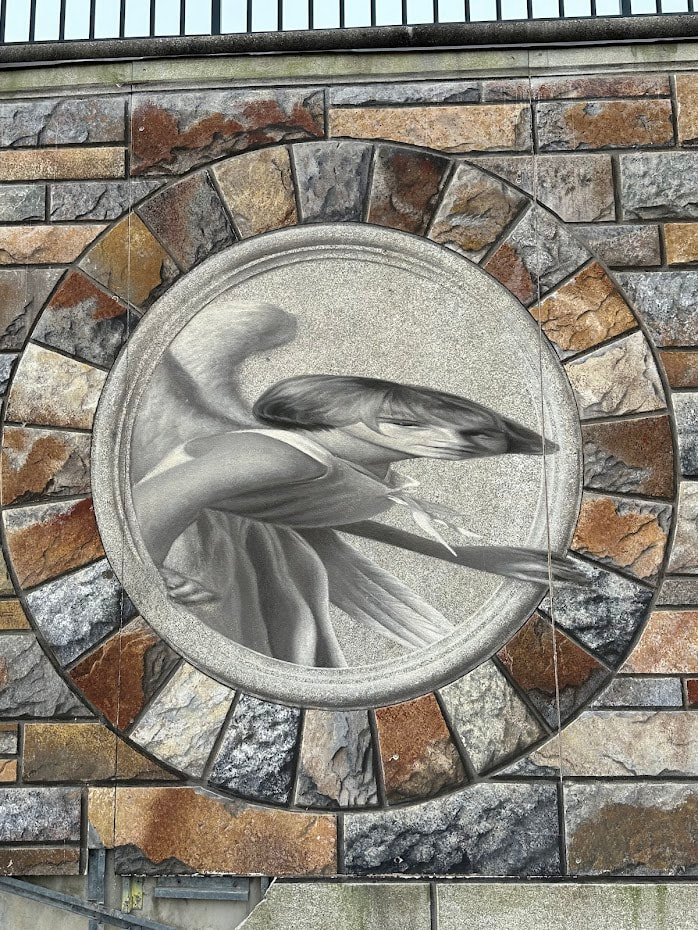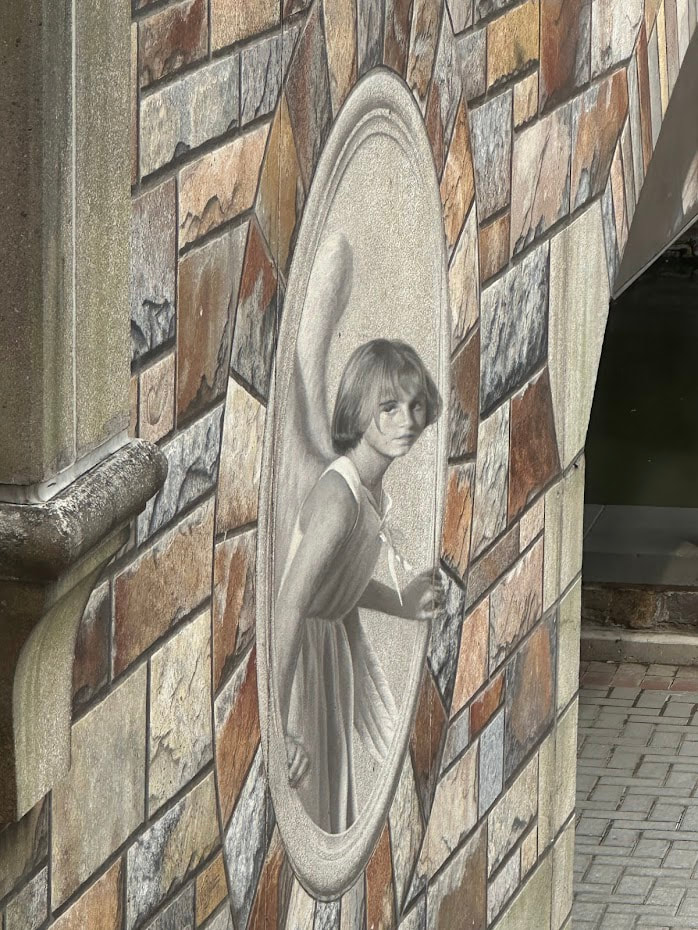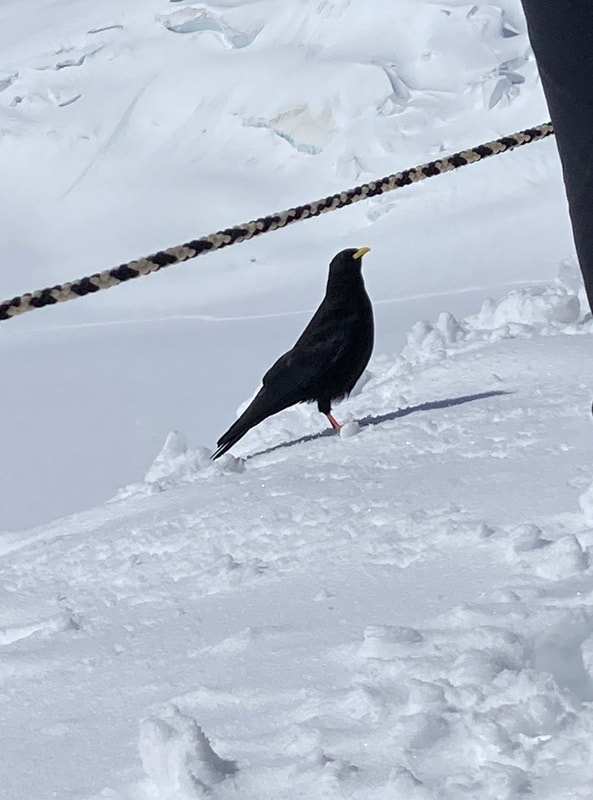|
I went to Carol Creek Linear Park in the city of Frederick, Maryland, and saw this amazing work or art by artist William Cochran. The art, entitled “Archangel”, when viewed head-on appears to be the distorted shape of a winged person. However, when you see it from an angle, you see a normal shape. These types of images are what is called an "anamorphosis". An anamorphosis exploits the fact that our brain puts together a representation of reality based on spatial and geometrical cues. If you manipulate these cues in certain ways, you can produce images that will only appear normal when viewed from certain vantage points. A remarkable historical example of an anamorphosis are the photos taken by Arthur Mole and John Thomas during World War I as part of a campaign to sell war bonds. These photos featured soldiers forming patriotic symbols. In the photo of the Statue of Liberty composition below, the anamorphic character of the image is revealed by the fact that of the 18,000 soldiers that were employed for the image, 12,000 of those soldiers were required just to form the flame part of the statue! Artists both amateur and professional have created many striking anamorphic images. However, far from being something limited to art, anamorphosis is something that has to be taken into account by individuals producing designs that people will see from an angle. Such is the case with road markings. The Archangel photo belongs to the author and cannot be used without permission. The statue of liberty photo is in the public domain.
0 Comments
Cats exhibit a behavior where they push out against a soft surface with their front paws alternating between the right and left paw while grasping the surface with each stroke. This behavior is reminiscent of a baker kneading dough and is sometimes referred to as “making biscuits”. As far as we can tell, kneading seems to be an instinctive behavior which most of the time indicates the animal feels secure or relaxed, although excessive kneading may indicate anxiety. There are many proposed explanations as to why cats knead. Among them are: signaling a desire for attention, showing affection, marking their territory, making their bed, stretching their muscles, and as a throw back to the times they were nursing and they would paw their mothers to stimulate the secretion of milk. In the video below, Science Cat demonstrates kneading behavior. When large flocks of birds start flying around back and forth over a given area, they are called a murmuration. Murmurations of birds are an amazing sight. The birds seem to follow each other, and their random movements create areas of low and high density of birds. The overall effect to the observer is that the flock of birds resembles one giant shape-shifting organism. This type of group behavior is also found in other living things such as insects or fish. Murmurations occur towards the end of the day when the birds are set to roost for the night, and they take place during the winter months. Although murmurations seem complex, the behavior that leads to the formation of a murmuration has been realistically recreated by computer simulations that follow simple rules. But why do murmurations happen? There are several hypotheses that have been put forward to explain murmurations. One is that the birds fly around to attract nearby birds in order to form large groups that will make them safer from predators. Another hypothesis is that birds join these large groups to share information about food sources. Yet a third hypotheses posits that the birds join these large groups to stay warmer during the night. The video shows a murmuration of starlings in Poolesville, Maryland. The video shows a light bulb that not only seems to be levitating while rotating but is also on, although it does not seem to be connected to a source of electricity. In case you are wondering, this is not a trick. The levitation is achieved by magnets. Magnets on the periphery of the base attract the light bulb, while magnets in the center of the base repel the light bulb. The result is that the light bulb is locked in position in midair. Once set in motion by a twist, the light bulb can rotate for a very long time because it experiences little friction from the air. As to how the light bulb is on, it is achieved by a phenomenon called “electromagnetic induction”, which was discovered by the English scientist Michael Faraday in 1831. Electromagnetic induction takes place when a moving magnetic field generates a current within a wire. In the case of the levitating light bulb, the base is connected to a power source that generates a moving magnetic field, which in turn induces the electric current inside the base of the light bulb. The principle of magnetic induction is behind electrical generators, and it powers all our electrical gadgets and appliances. With a height of 53 feet, Muddy Creek Falls is the highest free-falling waterfall in Maryland. The falls are in Garret County and are part of the Swallow Falls State Park. The rocks in the falls are mostly sandstones, siltstones, and shales belonging to a formation called the “Pottsville Formation” dating back to a geologic epoch called the Pennsylvanian Period some 300 million years ago. The waters of Muddy Creek Falls join the Youghiogheny River a few hundred feet below the falls. I recently visited Switzerland and took the train to the Jungfrauhoch. The Jungfrauhoch is a saddle-like ridge between two mountain peaks, the Jungfrau and the Monch, where Swiss ingenuity has built the tallest train station in Europe (11,362 feet) and a complex surrounding it that contains several tourist attractions as well as the highest observatory in Europe (the Sphinx Observatory). While there, I went out onto a panoramic point, and I filmed the video below. The video starts at the Jungfrau peak (13,642 feet), covers the Aletsch Glacier (the longest in Europe, 14 miles), and ends with views of the Sphinx Observatory and the Monch peak (13,484 feet). Apart from the beauty of the area, one thing that caught my attention were the birds. These birds are flying around at altitudes of 11,000 to 12,000 feet in an area where nothing grows, and where there are no insects. What are these birds, and what do they eat? After some research, I found out that these birds are called "Alpine Choughs" or “Yellow Billed Choughs” (Pyrrhocorax graculus). Chough is pronounced “chuff”. They belong to the same family as crows, and they build their nests at these high altitudes. But what do they eat? As it turns out, each day these birds fly many miles to feast on fruits, seeds, and invertebrates at lower elevations below the tree line, and then fly back up to their high places. The birds also eat whatever the tourists or the staff of sky resorts and other high places such as the Jungfrauhoch feed them. The images belong to the author and can only be used with permission. The Trümmelbach Falls in the Lauterbrunnen Valley in Switzerland are unusual in that, whereas most waterfalls fall off the side of a cliff, these falls tunnel through the rocks on the side of a mountain from a height of 460 feet in a total of ten falls some of which reach heights of 60 feet or more. The Trümmelbach Falls are the largest underground falls in Europe. The source of the water for these falls is snowmelt from the glaciers coming down the Eiger, Monch, and Jungfrau peaks, which rise to more than 13,000 feet above sea level. The water of Trümmelbach Falls has a turquoise color due to glacier debris, and at peak season the stream may carry more than 5,200 gallons of water per second. The layers of rocks through which the falls flow were laid down as mud rich in calcium carbonate in a shallow sea that covered the area 140 million years ago. Later on, these layers were compressed, turned into stone, and folded as a result of the tectonic uplifting that created the Alps over millions of years. Valleys such as the Lauterbrunnen Valley were sculpted by glaciers some 500,000 years ago. It is believed that during that time the Trümmelbach Falls began forming and acquired their present shape in the last 10,000 years. In the video below you can see the 7th fall of the Trümmelbach Falls framed by the steep walls of the Lauterbrunnen Valley in the background. In the next video below you can see the 9th fall of the Trümmelbach Falls. This video reveals the fact that part of the falls are subterranean. A phonograph is a device used to record and reproduce sound. The first phonograph was created by Thomas Edison in 1877, and the design was later improved by Alexander Graham Bell. In the first phonographs (also called gramophones) sound vibrations were engraved onto wax cylinders as grooves on the surface of the cylinder. Then the cylinder would be rotated, and a needle moved through the groves. The grooves caused the needle to vibrate, and the needle vibrations were amplified back into sound. By the second decade of the 1900s the wax cylinders had been replaced by discs or records, and the phonographs began to be referred to as “record players” and later “turntables”. By the 1980s the use of records and record players declined as a result of the introduction of cassettes and compact disks, and later digital music, but they are still used in niche markets and valued by collectors. In the video below, you can see a Victrola wind-up phonograph in operation. This phonograph is housed in the North Lee County Historical Society Museum in Fort Madison, Iowa. This brand of phonograph was made by the Victor Talking Machine Company, which in 1929 became RCA Victor. The Victrola features the famous logo of a dog listening to a phonograph with the caption “His Master’s Voice”. In the video below you can check out the murder mittens in action! The term “murder mittens” is a popular name for the paws of cats. Cats are predators and their paws are very well adapted for this function. Whereas humans have a form of locomotion that involves planting the heel of the foot (plantigrade) on the ground, cats walk on their toes or digits (digitigrade), which allows for more speed and a longer stride when running. Additionally, the paws of cats have pads that soften impacts and dampen the sounds they make when they are moving making them stealth predators. Finally, the paws of cats also have sharp retractable claws which are used to trap prey and also helps them climb. In the images below you can see science cat showing off her paws and also a mouse that she killed in our house. The images of Science cat belong to the author and can only be used with permission. Seasons have had and still have a profound effect in human history, society, and psychology. The dramatic changes in the landscape that occur throughout the year have affected and are still affecting many facets of humanity from trade and warfare to the economy and the arts, and from moods to physiology. But far from the seasons being a mystery, human beings through observation and experiment have been able to determine that the cause of the seasons is the tilt in the Earth’s axis. As the Earth orbits around the sun, it does so with a tilt of 23.5 degrees with respect to the plane of its orbit. As a result of this, the Earth’s poles point towards or away from the sun at the extremes of this orbit (solstices), while during the points of the orbit at right angles to the solstices neither one pole or the other point away from the sun (equinoxes). If the Earth’s axis did not have a tilt, there would be no seasons. Imagine how different human history, society, and psychology would be! In the images below, Science Cat demonstrates Summer, Fall, Winter and Spring with the help of an Azalea bush that grows outside of our living room window. Image from Wikipedia of the orbital relations of the Solstice, Equinox and intervening seasons by Colivine is used here under a CC0 1.0 Universal (CC0 1.0) Public Domain Dedication license. The images of Science Cat belong to the author and can only be used with permission. |
Details
Categories
All
Archives
April 2024
|








 RSS Feed
RSS Feed